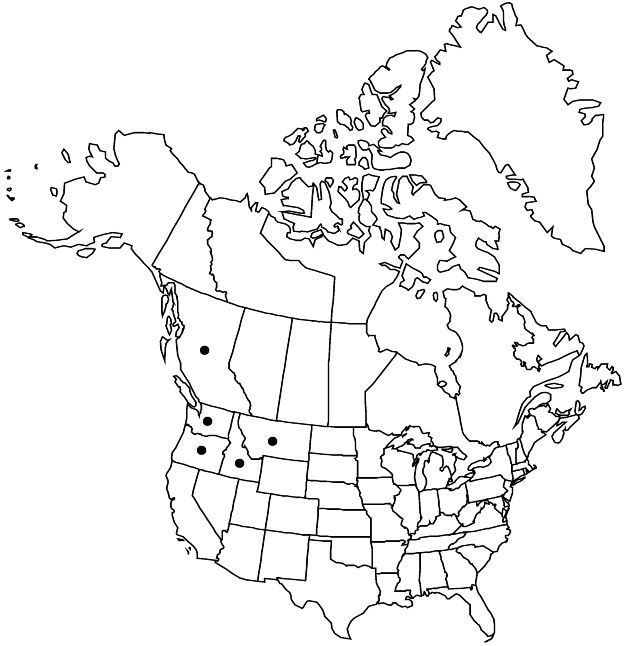Difference between revisions of "Amelanchier cusickii"
Erythea 7: 121. 1899.
FNA>Volume Importer |
FNA>Volume Importer |
||
| Line 16: | Line 16: | ||
|name=Amelanchier alnifolia var. cusickii | |name=Amelanchier alnifolia var. cusickii | ||
|authority=(Fernald) C. L. Hitchcock | |authority=(Fernald) C. L. Hitchcock | ||
| − | }}{{Treatment/ID/Synonym | + | }} {{Treatment/ID/Synonym |
|name=A. basalticola | |name=A. basalticola | ||
|authority=Piper | |authority=Piper | ||
| Line 34: | Line 34: | ||
|elevation=600–2300 m | |elevation=600–2300 m | ||
|distribution=B.C.;Idaho;Mont.;Oreg.;Wash. | |distribution=B.C.;Idaho;Mont.;Oreg.;Wash. | ||
| − | |discussion=<p>Amelanchier cusickii has distinctively long petals. Leaves that are glabrous upon expanding and glabrous or sparsely hairy ovary apices are also useful for identification. The species flowers before A. alnifolia, which suggests that the two are genetically distinct. G. N. Jones (1946) noted that A. alnifolia and A. cusickii frequently grow together and that there is no evidence of hybridization; the authors have observed hybridization between A. alnifolia var. semiintegrifolia and A. cusickii.</p> | + | |discussion=<p><i>Amelanchier cusickii</i> has distinctively long petals. Leaves that are glabrous upon expanding and glabrous or sparsely hairy ovary apices are also useful for identification. The species flowers before <i>A. alnifolia</i>, which suggests that the two are genetically distinct. G. N. Jones (1946) noted that <i>A. alnifolia</i> and <i>A. cusickii</i> frequently grow together and that there is no evidence of hybridization; the authors have observed hybridization between <i>A. alnifolia </i>var.<i> semiintegrifolia</i> and <i>A. cusickii</i>.</p> |
|tables= | |tables= | ||
|references= | |references= | ||
| Line 58: | Line 58: | ||
|publication year=1899 | |publication year=1899 | ||
|special status=Endemic | |special status=Endemic | ||
| − | |source xml=https://jpend@bitbucket.org/aafc-mbb/fna-data-curation.git/src/ | + | |source xml=https://jpend@bitbucket.org/aafc-mbb/fna-data-curation.git/src/8f726806613d60c220dc4493de13607dd3150896/coarse_grained_fna_xml/V9/V9_1121.xml |
|subfamily=Rosaceae subfam. Amygdaloideae | |subfamily=Rosaceae subfam. Amygdaloideae | ||
|tribe=Rosaceae tribe Gillenieae | |tribe=Rosaceae tribe Gillenieae | ||
Revision as of 18:14, 18 September 2019
Shrubs, 2–8 m. Stems 1–50, solitary or in colonies. Leaves fully unfolded; petiole (9–)12.8–19(–28) mm; blade elliptic to suborbiculate, (22–)33–46(–61) × (13–)25–32(–50) mm, base subcordate to truncate, each margin with (0 or)1–6(–11) teeth on proximal 1/2 and (2–)4 or 5(–7) teeth in distalmost cm, largest teeth 1 mm, apex usually truncate, sometimes mucronate to acute, abaxial surface glabrous or sparsely hairy by flowering, glabrous (or sparsely hairy) later, adaxial glabrous later. Inflorescences (4–)6–8(–10)-flowered, (17–)26–36(–47) mm. Pedicels: (0 or)1 or 2 subtended by a leaf, proximalmost (4–)9–14(–18) mm. Flowers: sepals erect to recurved after flowering, (2.6–)3.3–4.3(–5.3) mm; petals obovate to oblanceolate, (10.8–)13.3–20.1(–23.2) × (2.3–)3.3–6.3(–7.5) mm; stamens (14–)18–20(–21); styles (4 or)5, (1.7–)2.6–4(–4.8) mm; ovary apex glabrous or sparsely hairy (or with a ring of hairs at base of styles). Pomes bluish black, 10 mm diam. 2n = 4x.
Phenology: Flowering Mar–Jul; fruiting May–Aug.
Habitat: Basaltic ledges, cliffs, and bluffs along streams, stony soil, streambeds, stream banks, copses, mountainsides, roadsides
Elevation: 600–2300 m
Distribution

B.C., Idaho, Mont., Oreg., Wash.
Discussion
Amelanchier cusickii has distinctively long petals. Leaves that are glabrous upon expanding and glabrous or sparsely hairy ovary apices are also useful for identification. The species flowers before A. alnifolia, which suggests that the two are genetically distinct. G. N. Jones (1946) noted that A. alnifolia and A. cusickii frequently grow together and that there is no evidence of hybridization; the authors have observed hybridization between A. alnifolia var. semiintegrifolia and A. cusickii.
Selected References
None.